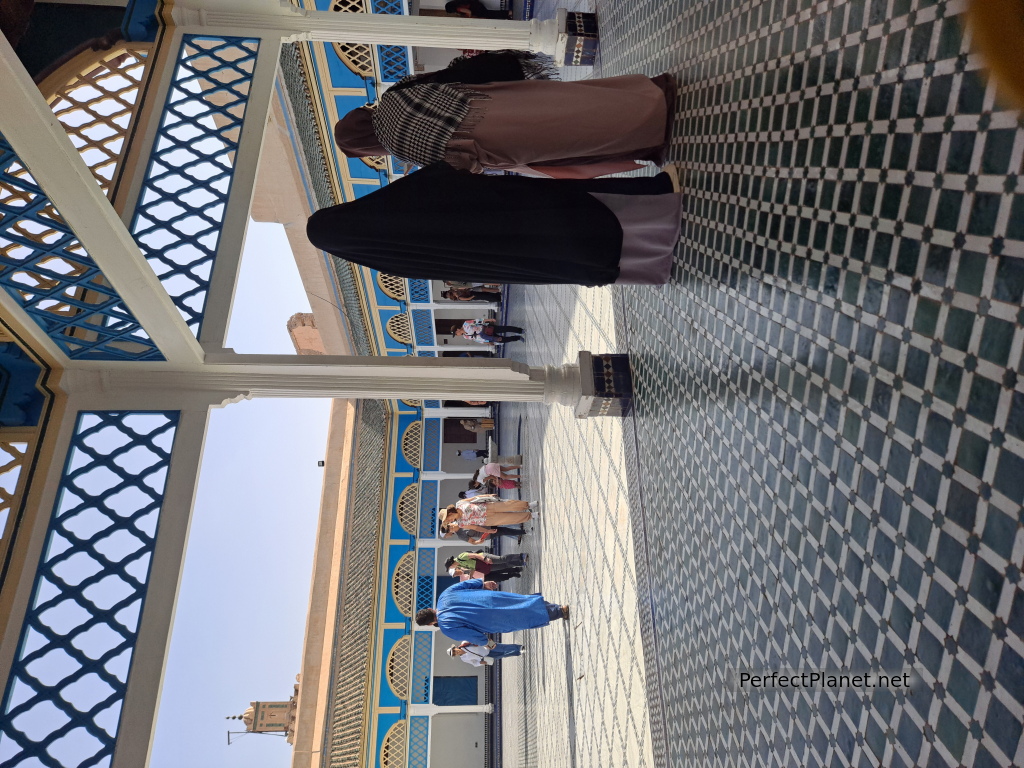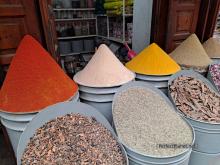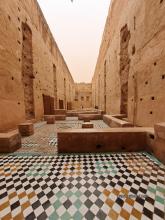Morocco, our African neighbour, is a fascinating destination to discover.

Erg Chegaga
A country of surprising contrasts where you can enjoy incredible mountains, desert landscapes, imperial cities, ancestral medinas, culture and tradition, which welcome the traveller with a warm welcome. Discover with us the magic of Morocco!
 Jebel Toubkal
Jebel Toubkal
Visa
Citizens of the Americas and most of Europe, including Spain, do not need a visa for stays of less than 90 days.
Money
The official currency is the Moroccan dirham (Dh), although the euro is accepted in some cities such as Tangier and Marrakech (10Dh = €1).
There are ATMs in the more touristy towns and cities, but be sure to check before arriving in certain areas to make sure you have enough cash on you. When using ATMs it is advisable to find out the minimum commissions per operation beforehand, as although the exchange rate is good you may be in for surprises. To avoid surprises we recommend using travel cards such as Vivid or Revolut, for more information follow this link.
It is important to know which is the best bank to withdraw money, for us Al Barid Bank did not give us any problem and charged the lowest commission, because even if you have the Revolut if the bank of destination charges commission they will charge you the same.
There is also an Al Barid Bank ATM at Marrakech airport, but you don't need to withdraw money unless you're going into town by bus, and if you're in a taxi you can pay in euros.
Credit card payments are not widely available, except in hypermarkets such as Carrefour or large hotels.

Marrakech souk
Almost everything is paid in cash in local currency. Some agencies, accommodation and car rental companies accept payment in euros, but be sure to check beforehand.
The best exchange rates are to be found in big cities like Marrakech , where we recommend you go to the Hotel Ali, next to Jemaa el-Fna square, the best exchange in the country and with no commissions.
Language
Morocco has two official languages, Arabic and Amazigh. Arabic is spoken throughout the country. A major effort is being made to revive Amazigh or Tamazigh, the language of the original Berber people, which is still spoken in the Rif Mountains (in the north), in the Atlas area and in southern Morocco.
French is another widely spoken language. Morocco was a French colony until 1956 and for many years it was a co-official language, but nowadays it is not compulsory in schools and is being replaced by the study of English.
Spanish is another of the languages most widely spoken by Moroccans, especially in northern areas such as Tangier and Tetouan, which were once Spanish protectorates.
 Kasbah of Taourirt
Kasbah of Taourirt
Transport
Getting around Morocco is simple and inexpensive, offering multiple alternatives adapted to each traveller.
By bus. This is the cheapest way to get around, especially in the centre and north of the country. If you want to travel in the south, you need to travel slowly and with time.
The main bus companies are Supratours and CTM, although they are not the only ones. We travelled with CTM from Fez to Chefchaouen by bus for 14€/pax, the journey takes between four and a half and five hours and we were able to buy the ticket online. When you arrive at the station you have to check in your backpack which costs 5dh. The stations are quiet and the platforms are controlled.
Train. Another cheap and well-functioning option is the train. The main cities in central and western Morocco are connected by train, including high-speed trains. You can choose to travel first or second class. We opted for the latter to travel the distance between Tangier and Asilah by train, which took about 40 minutes and cost us 40dh/two pax/trip. The train station in Tangier is very modern, you can even get your tickets from automatic machines.
Taxi. There are two types of taxis in Morocco, grand taxi and petit taxi. The petit taxi only takes three passengers and travels short distances within the cities, they are very cheap.
Grand taxis cover the same distances as the buses, but usually hold six or seven people and although they are cheap, they leave when they are full, so if you are in a hurry it is not a good option as you will have to pay the full fare.
In both cases you always have to negotiate the price in advance as they are not metered.
You can also hire a car with a private chauffeur although you will have to negotiate the price, the bigger the vehicle and the more people the better.
Van. Many agencies offer tours that connect the country's main tourist attractions. If you are short on time, this is an option and they are not expensive.

Marrakech souk
Car. Renting a car is one of the most comfortable and relaxing ways to visit the country, especially in the south, where there is little traffic and the roads are very good. In the north there is much more traffic and driving is more aggressive, especially around Fez where the traffic is hellish.
If you are European, you don't need an international driving licence and you can drive in Morocco with your national driving licence.
Remember, you have to be careful if you drive at night, in Morocco it is allowed to drive without lights if you are going less than 20 km/hour.
We rented a car with SAMICAR. It is not the cheapest but it offers full insurance with no excess and no down payment. For dropping the car off in a different city they do not charge an additional fee. We paid for a large car, a Dacia Logan, for four people 480€ and an additional 15€ for a second driver.
It is not necessary to rent a 4x4, but if you want to visit the desert and go deep into it, it is better to hire the services of an agency. To visit Erg Chegaga in the Sahara we hired the company Hamid Morocco routes. Two days in the desert with 4x4, driver and guide included.

Chouwara
Accomodation
Morocco has accommodation to suit all budgets, from luxury riads to budget hotels to desert campsites. If you use apps such as Booking or Airbnb it's advisable to check the reviews for cleanliness of the accommodation.
You can't visit Morocco without staying in a riad, these ancient buildings have a central courtyard or garden around which the rooms are arranged. We recommend Riad Tamazaouzt in Marrakech, which is cheap, clean and well located in the Medina. If you prefer to stay on the outskirts and you have a car, Le Domine de Carole is the ideal destination, a small oasis with a pool, garden and incredible rooms for only 40€/night/2pax.

Le Domine de Carol
Another interesting option in southern Morocco is to stay in an old Kasbah or fortified palace. We did it in Kasbah Omari in Tinerhir, quite cheap, it was quite an experience and our terrace overlooked a dreamy palm grove.
In the desert, it's worth spending at least one night in a camp to feel a bit nomadic, even if you have all the comforts. We recommend you to do it in Erg Chegaga, contact Hamid's company www.marruecosrutas.com.

Souk
Health
Before you start your trip, always contact the international disease service. Don't forget a first aid kit with the essentials: medicines, betadine, antibiotic ointment, syringes, frontal, bandages, plasters, scissors, mosquito net, mosquito repellent, sun cream.
It is essential that you take out travel insurance that includes medical cover, we recommend IATI Backpacker, the best insurance for travelling to Morocco, on our website you will find a 5% discount.
Security
Morocco is a fairly safe country In recent years, the Moroccan government has been working to prevent insecurity, especially in the big cities. However, you should always keep an eye on your belongings, especially in the souks and crowded areas.
Areas considered risky by the Ministry of Foreign Affairs to avoid are military zones, unmarked desert areas and those near the border with Algeria.

Sunrise in Atlas
Gastronomy
Typical Moroccan food is a madness of flavours, including spices such as turmeric and cumin. Each area cooks the same dishes but in a different way, so you want to try them all.
The prices are very varied, you can get between 80dh and 120dh for a menu with a starter, main course and dessert, which we can assure you will be enough for two people. We have mistakenly ordered two menus in some places and the dessert and bread were served for dinner. In the restaurants you can order a dish or a menu to share and even bring your own drink.

Breakfast
Among the most famous Moroccan dishes we recommend the following:
Harira, a vegetable and vegetable soup.

Pastela
Pastela or pastilla, filo pastry with chicken or lamb and ground almonds covered with honey or icing sugar.
Tajine. The Moroccan star dish is named after the earthenware pot used to cook it. It is delicious in all its versions: you can find them with vegetables, chicken with lemon and olives, lamb with plums, veal and goat.

Tajines
Tanjia. Like tajine, this dish is named after the pot. The meat is cooked without vegetables.
Cous cous. This type of pasta accompanies many dishes, such as chicken or meat tajine.
Bread. Moroccan bread is delicious, we recommend you try it in all its versions. It often tends to be sweet.
Moroccan salad. Sometimes raw, sometimes stewed.

Moroccan salad
Drinks.The mint tea and juices are delicious.In addition to the traditional juices (ask them without ice or sugar), we recommend you try the avocado juice with dried fruit that is drunk in the north of the country.
Tea is usually accompanied by pastries, Moroccan sweets and even popcorn, the combination may not seem like it, but it works.
Buying alcohol is only possible in Carrefour and shops specialising in liquor. Prices are similar to those in Spain. In Carrefour there is a specific section only for alcohol and you pay extra.There are Carrefour in the main cities although they do not always have alcohol.

Mint te
Conectivity
Maroc Telecom, Orange or Inwi are the main telephone companies in Morocco.
Any of these companies offer prepaid SIM cards for local use. We bought one at Marrakech airport with Maroc Telecom for €20 with Gb.
You can also buy the SIM card in your home country, but it's usually more expensive.

Erg Chebi
Activities
Morocco offers a world of possibilities, experiences and unforgettable activities, from climbing the Yebel Toubkal, the highest mountain in North Africa, to becoming a nomad for a few days enjoying the immensity of theSahara desert .
In the Atlas Mountains and the Rif Mountains you can do various types of trekking adapted to all levels, from classic mountain climbing and mountain biking to discovering the Amazigh culture by visiting the small Berber villages that surround them, we recommend www.subidaaltoubkal.com.
In the south you can enjoy unique architecture by visiting what is known as the route of the thousand Kasbahs, along with oases and palm groves that are UNESCO World Heritage Sites.

Kasbah
A Kasbah is a fortified space of Berber origin, designed to protect against both attacks by intruders and inclement weather. Kasbahs are part of traditional Moroccan architecture, like a small town with a manor house to receive visitors and labyrinthine streets linking different rooms such as kitchens and stables. A place protected by high walls of adobe bricks (dried in the sun) or pressed earth, straw and stones.
Kasbahs are often surrounded by Ksour, fortified villages with narrow streets and defensive towers.

Kasbah
In the desert you can opt for dromedary rides, quad biking, cycling, 4x4 or just stroll through the dunes if the weather permits. On the beach you can go surfing, kite surfing, horse riding and/or camel riding or even hot air ballooning. As you can see the possibilities are endless!

Erg Chegaga
Society
Moroccan society is open and welcoming to travellers. Despite being a majority Muslim country, they follow the Sunni trend, which is less strict than the Shi'a. They are very traditional, although there are big differences between north and south and between rural and urban areas.
Moroccan society is very traditional, although large differences are beginning to emerge between north and south and between rural and urban areas.
Literacy rates are improving, schooling is free for all.
In rural areas women still have a very traditional role in relation to the family, managing the family economy and the children but subordinate to men, especially their husbands. It is practically impossible to see a woman running a business or having a coffee in a café.

Women in Bahia Palace
In urban areas things are changing little by little and we can see more modern women without yihab, walking with friends and enjoying a coffee or tea on a terrace. They can also be seen running a business such as a shop, manning the front desk of a hotel or controlling traffic.
Moroccans are normally respectful of foreign women but it is recommended to dress ‘discreetly’, such as covering shoulders and knees, not wearing low-cut necklines or transparent clothing, especially if you are travelling alone, to avoid unpleasant situations.
- Log in to post comments







